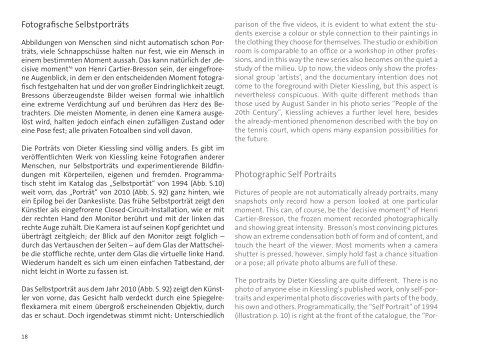DIETER KIESSLING - home
DIETER KIESSLING - home
DIETER KIESSLING - home
Sie wollen auch ein ePaper? Erhöhen Sie die Reichweite Ihrer Titel.
YUMPU macht aus Druck-PDFs automatisch weboptimierte ePaper, die Google liebt.
Fotografische Selbstporträts<br />
Abbildungen von Menschen sind nicht automatisch schon Porträts,<br />
viele Schnappschüsse halten nur fest, wie ein Mensch in<br />
einem bestimmten Moment aussah. Das kann natürlich der ‚decisive<br />
moment‘ 6 von Henri Cartier-Bresson sein, der eingefrorene<br />
Augenblick, in dem er den entscheidenden Moment fotografisch<br />
festgehalten hat und der von großer Eindringlichkeit zeugt.<br />
Bressons überzeugendste Bilder weisen formal wie inhaltlich<br />
eine extreme Verdichtung auf und berühren das Herz des Betrachters.<br />
Die meisten Momente, in denen eine Kamera ausgelöst<br />
wird, halten jedoch einfach einen zufälligen Zustand oder<br />
eine Pose fest; alle privaten Fotoalben sind voll davon.<br />
Die Porträts von Dieter Kiessling sind völlig anders. Es gibt im<br />
veröffentlichten Werk von Kiessling keine Fotografien anderer<br />
Menschen, nur Selbstporträts und experimentierende Bildfindungen<br />
mit Körperteilen, eigenen und fremden. Programmatisch<br />
steht im Katalog das „Selbstportät“ von 1994 (Abb. S.10)<br />
weit vorn, das „Porträt“ von 2010 (Abb. S. 92) ganz hinten, wie<br />
ein Epilog bei der Dankesliste. Das frühe Selbstporträt zeigt den<br />
Künstler als eingefrorene Closed-Circuit-Installation, wie er mit<br />
der rechten Hand den Monitor berührt und mit der linken das<br />
rechte Auge zuhält. Die Kamera ist auf seinen Kopf gerichtet und<br />
überträgt zeitgleich; der Blick auf den Monitor zeigt folglich –<br />
durch das Vertauschen der Seiten – auf dem Glas der Mattscheibe<br />
die stoffliche rechte, unter dem Glas die virtuelle linke Hand.<br />
Wiederum handelt es sich um einen einfachen Tatbestand, der<br />
nicht leicht in Worte zu fassen ist.<br />
Das Selbstporträt aus dem Jahr 2010 (Abb. S. 92) zeigt den Künstler<br />
von vorne, das Gesicht halb verdeckt durch eine Spiegelreflexkamera<br />
mit einem übergroß erscheinenden Objektiv, durch<br />
das er schaut. Doch irgendetwas stimmt nicht: Unterschiedlich<br />
18<br />
parison of the five videos, it is evident to what extent the students<br />
exercise a colour or style connection to their paintings in<br />
the clothing they choose for themselves. The studio or exhibition<br />
room is comparable to an office or a workshop in other professions,<br />
and in this way the new series also becomes on the quiet a<br />
study of the milieu. Up to now, the videos only show the professional<br />
group ‘artists’, and the documentary intention does not<br />
come to the foreground with Dieter Kiessling, but this aspect is<br />
nevertheless conspicuous. With quite different methods than<br />
those used by August Sander in his photo series “People of the<br />
20th Century”, Kiessling achieves a further level here, besides<br />
the already-mentioned phenomenon described with the boy on<br />
the tennis court, which opens many expansion possibilities for<br />
the future.<br />
Photographic Self Portraits<br />
Pictures of people are not automatically already portraits, many<br />
snapshots only record how a person looked at one particular<br />
moment. This can, of course, be the ‘decisive moment’ 6 of Henri<br />
Cartier-Bresson, the frozen moment recorded photographically<br />
and showing great intensity. Bresson’s most convincing pictures<br />
show an extreme condensation both of form and of content, and<br />
touch the heart of the viewer. Most moments when a camera<br />
shutter is pressed, however, simply hold fast a chance situation<br />
or a pose; all private photo albums are full of these.<br />
The portraits by Dieter Kiessling are quite different. There is no<br />
photo of anyone else in Kiessling’s published work, only self-portraits<br />
and experimental photo discoveries with parts of the body,<br />
his own and others. Programmatically, the “Self Portrait” of 1994<br />
(illustration p. 10) is right at the front of the catalogue, the “Por-


